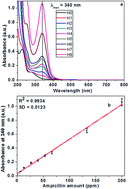In situ formation of carbon dots aids ampicillin sensing†
Abstract
A simple analytical method is designed for the detection of micro-molar concentrations of an antibiotic with a β-lactam subunit. The sensor for ampicillin has a limit of detection, LOD, value of 0.165 × 10−4 M and exhibited linearity over a wide range of ampicillin concentrations (6.6–200 ppm). The detection of the antibiotic is based on the in situ generation of carbon nanodots (CNDs) via a hydrothermal reaction between glucose and the antibiotic moiety. The CNDs exhibited characteristic absorption at 340 nm whose intensity is a measure of the initial ampicillin concentration. The CNDs possess peculiar blue emission which is excitation independent. The particle size of CNDs is in the range of 8–40 nm and they are hydrophilic in nature. NMR spectral analysis revealed insights into the carbon nano-structure comprising of an aromatic core with carbonyl type functionalities on its surface. Synthesis of carbon dots from ampicillin in aqueous medium and utilizing the absorption properties as well as the emission properties of the carbon dots generated for the detection of ampicillin make the design and operation of the sensor environmentally friendly and simple.


 Please wait while we load your content...
Please wait while we load your content...